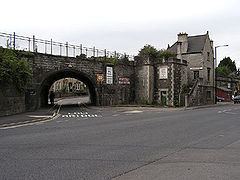Population 5,905 (2011.ward) Sovereign state United Kingdom UK parliament constituency Bath | OS grid reference ST723642 Dialling code 01225 Post town Bath | |
 | ||
Unitary authority | ||
Twerton is a suburb of the city of Bath, Somerset, England, situated to the west of the city, and home to the city's football club, Bath City.
Contents
Map of Twerton, Bath, UK
Twerton is served by bus route 5, operated by First Somerset & Avon buses in the Bath area. For a time, there was a duplicate Wessex Connect service, operating under the name Royal Bath. This was discontinued in the summer of 2013. Wessex Connect does still operate the circular route 20A/C (the suffixes denoting anticlockwise and clockwise services respectively), a route previously operated by First.
Twerton high street houses pubs, a minimarket, a new Morrisons local (as of autumn 2013) formerly Blockbuster, a bakery, and two hairdressing salons.
The Whiteway housing estate is located in the south of the Twerton electoral ward.
History
The Domesday Book of 1086 records that Twerton was held by Nigel de Gournay, who would have won his lands in Englishcombe, Twerton, Swainswick and Barrow Gurney by fighting for William I of England. His original home must have been Gournay, which was half-way between Dieppe and Paris. The parish of Twerton was part of the Wellow Hundred.
Thomas de Gournay was involved with the murder of Edward II at Berkeley Castle in 1327.
At the time when Brunel was designing the Great Western Railway, his plan was for the line from Bath to Bristol to go through the centre of Twerton. The landowner, named Wilkins, was so enthusiastic about the railway that he paid for the village to be demolished to make room, then rebuilt it next to the line. The railway station on the main line, called Twerton-on-Avon, survived until 1917. Twerton was also the terminus of one line of the Bath tramway system until that closed in 1939.
St Michael's church was enlarged in 1824 by local architect John Pinch the elder and rebuilt in 1839 by the city architect George Phillips Manners. Twerton Gaol was built by Manners in 1840 and closed in 1878. Only the governor's house survives, now converted into apartments.
The author Henry Fielding who wrote Tom Jones lived in Twerton and is believed to have written most of the novel while living there. His house was demolished for road improvements by Bath City Council in the 1960s.
Geography
Carrs Woodland is a 21.1 hectares (52 acres) local nature reserve in the valley of Newton Brook. It includes the notable bath asparagus. Twerton Roundhill is a 4.66 hectares (11.5 acres) nature reserve of grassland with a range of wildflowers including greater knapweed and agrimony.
